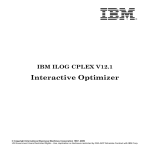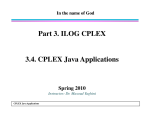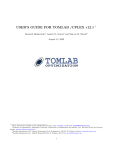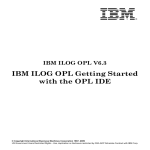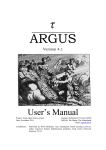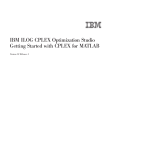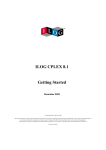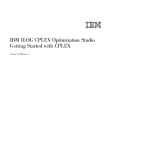Download Release notes for CPLEX (12.1)
Transcript
IBM ILOG CPLEX V12.1 Release notes for CPLEX © Copyright International Business Machines Corporation 1987, 2009 US Government Users Restricted Rights - Use, duplication or disclosure restricted by GSA ADP Schedule Contract with IBM Corp. Legal terms Copyright notice © Copyright International Business Machines Corporation 1987, 2009. US Government Users Restricted Rights - Use, duplication or disclosure restricted by GSA ADP Schedule Contract with IBM Corp. Trademarks IBM, the IBM logo, ibm.com, WebSphere, ILOG, the ILOG design, and CPLEX are trademarks or registered trademarks of International Business Machines Corp., registered in many jurisdictions worldwide. Other product and service names might be trademarks of IBM or other companies. A current list of IBM trademarks is available on the Web at "Copyright and trademark information" at http://www.ibm.com/legal/copytrade.shtml Adobe, the Adobe logo, PostScript, and the PostScript logo are either registered trademarks or trademarks of Adobe Systems Incorporated in the United States, and/or other countries. Linux is a registered trademark of Linus Torvalds in the United States, other countries, or both. Microsoft, Windows, Windows NT, and the Windows logo are trademarks of Microsoft Corporation in the United States, other countries, or both. Java and all Java-based trademarks and logos are trademarks of Sun Microsystems, Inc. in the United States, other countries, or both. Other company, product, or service names may be trademarks or service marks of others. Further notices Additional registered trademarks Python® is a registered trademark of the Python Software Foundation. MATLAB® is a registered trademark of The MathWorks, Inc. Acknowledgement of use: dtoa routine of the gdtoa package ILOG acknowledges use of the dtoa routine of the gdtoa package, available at http://www.netlib.org/fp/. The author of this software is David M. Gay. All Rights Reserved. Copyright (C) 1998, 1999 by Lucent Technologies Permission to use, copy, modify, and distribute this software and its documentation for any purpose and without fee is hereby granted, provided that the above copyright notice appears in all copies and that both that the copyright notice and this permission notice and warranty disclaimer appear in supporting documentation, and that the name of Lucent or any of its entities not be used in advertising or publicity pertaining to distribution of the software without specific, written prior permission. LUCENT DISCLAIMS ALL WARRANTIES WITH REGARD TO THIS SOFTWARE, INCLUDING ALL IMPLIED WARRANTIES OF MERCHANTABILITY AND FITNESS. IN NO EVENT SHALL LUCENT OR ANY OF ITS ENTITIES BE LIABLE FOR ANY SPECIAL, INDIRECT OR CONSEQUENTIAL DAMAGES OR ANY DAMAGES WHATSOEVER RESULTING FROM LOSS OF USE, DATA OR PROFITS, WHETHER IN AN ACTION OF CONTRACT, NEGLIGENCE OR OTHER TORTIOUS ACTION, ARISING OUT OF OR IN CONNECTION WITH THE USE OR PERFORMANCE OF THIS SOFTWARE. (end of license terms of dtoa routine of the gdtoa package) C O N T E N T S Table of contents For technical support.................................................................................................7 Contacting IBM Support.............................................................................................................8 Release Notes for ILOG CPLEX 12.0......................................................................11 Welcome to ILOG CPLEX 12.0..................................................................................................13 Conversion notes for all users: parallel optimizers enabled by default...............................14 Conversion notes for all users: port changes........................................................................15 Conversion notes for Concert Technology users: deprecated methods..............................16 New feature: CPLEX connector for The MathWorks MATLAB...............................................20 New feature: CPLEX Python API..............................................................................................21 New feature: multi-commodity flow (MCF) cuts.....................................................................22 New feature for Java or .NET users: piecewise linear numeric expression.........................23 New feature: deterministic parallel barrier algorithm............................................................24 New feature: parallel algorithms available to all users..........................................................25 Release notes of IBM ILOG CPLEX V12.1..............................................................27 New feature: CPLEX connector for Microsoft Excel..............................................................28 Index..........................................................................................................................29 © Copyright IBM Corp. 1987, 2009 5 6 R E L E A S E N O T E S F O R C P L E X For technical support Explains prerequisites and procedure for technical support of the product. In this section Contacting IBM Support Contains information on how to obtain technical support from IBM worldwide, should you encounter any problems in using IBM products. © Copyright IBM Corp. 1987, 2009 7 Contacting IBM Support IBM Software Support Handbook This guide contains important information on the procedures and practices followed in the service and support of your IBM products. It does not replace the contractual terms and conditions under which you acquired specific IBM Products or Services. Please review it carefully. You may want to bookmark the site so you can refer back as required to the latest information. The "IBM Software Support Handbook" can be found on the web at http:// www14.software.ibm.com/webapp/set2/sas/f/handbook/home.html. Accessing Software Support When calling or submitting a problem to IBM Software Support about a particular service request, please have the following information ready: ♦ IBM Customer Number ♦ The machine type/model/serial number (for Subscription and Support calls) ♦ Company name ♦ Contact name ♦ Preferred means of contact (voice or email) ♦ Telephone number where you can be reached if request is voice ♦ Related product and version information ♦ Related operating system and database information ♦ Detailed description of the issue ♦ Severity of the issue in relationship to the impact of it affecting your business needs Contact by Web Open service requests is a tool to help clients find the right place to open any problem, hardware or software, in any country where IBM does business. This is the starting place when it is not evident where to go to open a service request. Service Request (SR) tool offers Passport Advantage clients for distributed platforms online problem management to open, edit and track open and closed PMRs by customer number. Timesaving options: create new PMRs with prefilled demographic fields; describe problems yourself and choose severity; submit PMRs directly to correct support queue; attach troubleshooting files directly to PMR; receive alerts when IBM updates PMR; view reports on open and closed PMRs. You can find information about assistance for SR at http:// www.ibm.com/software/support/help-contactus.html System Service Request (SSR) tool is similar to Electronic Service request in providing online problem management capability for clients with support offerings in place on System 8 R E L E A S E N O T E S F O R C P L E X i, System p, System z, TotalStorage products, Linux, Windows, Dynix/PTX, Retail, OS/2, Isogon, Candle on OS/390 and Consul z/OS legacy products. IBMLink SoftwareXcel support contracts offer clients on the System z platform the IBMLink online problem management tool to open problem records and ask usage questions on System z software products. You can open, track, update, and close a defect or problem record; order corrective/preventive/toleration maintenance; search for known problems or technical support information; track applicable problem reports; receive alerts on high impact problems and fixes in error; and view planning information for new releases and preventive maintenance. Contact by phone If you have an active service contract maintenance agreement with IBM , or are covered by Program Services, you may contact customer support teams by telephone. For individual countries, please visit the Technical Support section of the IBM Directory of worldwide contacts. R E L E A S E N O T E S F O R C P L E X 9 10 R E L E A S E N O T E S F O R C P L E X Release Notes for ILOG CPLEX 12.0 Thank you for installing ILOG CPLEX 12.0. Before using it, please review these notes highlighting new features in this version. In this section Welcome to ILOG CPLEX 12.0 Describes what to expect in this version. Conversion notes for all users: parallel optimizers enabled by default Explains the new policy making parallel optimizers available by default. Conversion notes for all users: port changes Lists additional ports available in this release and ports removed from this release. Conversion notes for Concert Technology users: deprecated methods Lists methods deprecated in ILOG CPLEX 12.0 and recommends replacements for them. New feature: CPLEX connector for The MathWorks MATLAB Describes the new connector of CPLEX to this engineering software. New feature: CPLEX Python API Describes the new fully-supported Python API for CPLEX. New feature: multi-commodity flow (MCF) cuts Describes a new type of cut available for problems with network flow structure. New feature for Java or .NET users: piecewise linear numeric expression Introduces a method for creating a piecewise linear numeric expression in the Java and .NET APIs. © Copyright IBM Corp. 1987, 2009 11 New feature: deterministic parallel barrier algorithm Announces that deterministic mode for the parallel barrier optimizer is available. New feature: parallel algorithms available to all users Announces technical aspects of a change in the licensing policy for parallel applications. 12 R E L E A S E N O T E S F O R C P L E X Welcome to ILOG CPLEX 12.0 In addition to the performance increase you expect with a major new release, ILOG CPLEX 12.0 introduces new features making it easier than ever to connect to engineering and scientific software. This release offers a connector to The MathWorks MATLAB. This new version also offers a full-featured Python application programming interface (API) supporting all aspects of CPLEX optimization. Conversion notes for all users: parallel optimizers enabled by default announces a policy change in licensing of interest to users with multi-core or multi-CPU computers running CPLEX applications. Conversion notes for all users: port changes discusses the additional port available in this release as well as replacements for ports no longer available. Conversion notes for Concert Technology users: deprecated methods lists methods deprecated in this release and recommends replacements for them. Here is more detail about major new features in this release: ♦ New feature: CPLEX connector for The MathWorks MATLAB ♦ New feature: CPLEX Python API ♦ New feature: multi-commodity flow (MCF) cuts R E L E A S E N O T E S F O R C P L E X 13 Conversion notes for all users: parallel optimizers enabled by default With this release, the default ILOG CPLEX license enables the parallel versions of the barrier and mixed integer programming (MIP) optimizers. That is, on shared memory, multi-core, or multi-CPU computers, these optimizers are enabled by default to use a number of threads equal to the total number of cores. This change is a change in licensing only. User control of the number of parallel threads remains available through a parameter (Threads in the Concert APIs, CPX_PARAM_THREADS in the Callable Library, set threads in the Interactive Optimizer) if the user prefers a lesser degree of parallelism. For customers already using Parallel CPLEX in earlier versions of the product, new licenses issued under maintenance contracts continue to work the same way for those versions, while supporting this new version. 14 R E L E A S E N O T E S F O R C P L E X Conversion notes for all users: port changes A new port x86-64_darwin8_gcc4.0 has been added to support the Macintosh operating system on 64-bit architecture. This 64-bit extension to x86 architecture is also known as AMD64 or EMT64. The new port power32_aix5.3_7.0 replaces power32_aix5.2_7.0, which is no longer available. Likewise, the new port power64_aix5.3_7.0 replaces power64_aix5.2_7.0, which is no longer available. For a complete list of machine types and library formats (including version numbers of compilers and JDKs) see the file yourCPLEXhome /mptable.html . R E L E A S E N O T E S F O R C P L E X 15 Conversion notes for Concert Technology users: deprecated methods All of the methods deprecated in this release are ways for a user to access information either through a goal or through a callback. All of the deprecated methods count the number of cuts of a particular type that CPLEX has added to a model. (A more general method, getNcuts, that allows a user to specify a type of cut and count the number of added cuts still exists in this version, and it is not deprecated for use in goals or callbacks.) These methods have been deprecated in ILOG CPLEX 12.0 and will be removed from a future version of the product. ♦ In the C++ API ● ● 16 R E L E A S E In the class IloCplex::GoalI ♦ getNcliques ♦ getNcovers ♦ getNdisjunctiveCuts ♦ getNflowCovers ♦ getNflowPaths ♦ getNfractionalCuts ♦ getNGUBcovers ♦ getNimpliedBounds ♦ getNMIRs ♦ getNzeroHalfCuts In the class IloCplex::MIPCallbackI ♦ getNcliques ♦ getNcovers ♦ getNdisjunctiveCuts ♦ getNflowCovers ♦ getNflowPaths ♦ getNfractionalCuts ♦ getNGUBcovers ♦ getNimpliedBounds ♦ getNMIRs ♦ getNzeroHalfCuts N O T E S F O R C P L E X ♦ In the Java API ● ● ♦ In the class IloCplex.Goal ♦ getNcliques ♦ getNcovers ♦ getNdisjunctiveCuts ♦ getNflowCovers ♦ getNflowPaths ♦ getNfractionalCuts ♦ getNGUBcovers ♦ getNimpliedBounds ♦ getNMIRs ♦ getNzeroHalfCuts In the class IloCplex.MIPCallback ♦ getNcliques ♦ getNcovers ♦ getNdisjunctiveCuts ♦ getNflowCovers ♦ getNflowPaths ♦ getNfractionalCuts ♦ getNGUBcovers ♦ getNimpliedBounds ♦ getNMIRs ♦ getNzeroHalfCuts In the .NET API ● In the class Cplex.Goal ♦ Ncliques ♦ Ncovers ♦ NdisjunctiveCuts ♦ NflowCovers R E L E A S E N O T E S F O R C P L E X 17 ● ♦ NflowPaths ♦ NfractionalCuts ♦ NGUBcovers ♦ NimpliedBounds ♦ NMIRs ♦ NzeroHalfCuts In the class Cplex.MIPCallback ♦ Ncliques ♦ Ncovers ♦ NdisjunctiveCuts ♦ NflowCovers ♦ NflowPaths ♦ NfractionalCuts ♦ NGUBcovers ♦ NimpliedBounds ♦ NMIRs ♦ NzeroHalfCuts If you use any of those deprecated methods in your applications, ILOG recommends that you replace them with this method instead: getNcuts(type); where the argument type specifies the type of cut that the deprecated method counts. In other words, use the following methods to access the number of cuts added by CPLEX, whether the access is from a goal or a callback. ♦ In the C++ API, use IloCplex::getNcuts(type) or IloCplex::GoalI::getNcuts(type) or IloCplex::MIPCallbackI::getNcuts(type). ♦ In the Java API, use IloCplex.getNcuts(type) or IloCplex.Goal.getNcuts(type) or IloCplex.MIPCallback.getNcuts(type). ♦ In the .NET API, use Cplex.GetNcuts(type). The possible values of the argument type depend on the interface. 18 ♦ In the C++ API, use the values of the enumeration IloCplex::CutType. ♦ In the Java API, use the fields of the class IloCplex.CutType. R E L E A S E N O T E S F O R C P L E X ♦ In the .NET API, use the attributes of the class Cplex.CutType. R E L E A S E N O T E S F O R C P L E X 19 New feature: CPLEX connector for The MathWorks MATLAB The CPLEX connector for The MathWorks MATLAB enables a user to define optimization problems and solve them within MATLAB. In other words, a student or practitioner who is already adept in MATLAB can easily solve optimization problems within that framework. The new CPLEX connector for MATLAB offers two alternative approaches to this engineering software: ♦ The basic toolbox functions accept a model description as input and produce a solution as output. ♦ The CPLEX class API to MATLAB supports more sophisticated CPLEX features, such as restarts or model decomposition, within MATLAB. Documentation for the CPLEX MATLAB connector is available in several forms: 20 ♦ Online help is available inside a MATLAB session. ♦ A new tutorial introduces the CPLEX MATLAB connector through a complete sample of modeling and solving a typical LP problem. This tutorial is available in the user's manual accompanying the CPLEX for MATLAB connector. ♦ More than forty examples accompany the new CPLEX MATLAB connector, covering both the class API and the toolbox functions. R E L E A S E N O T E S F O R C P L E X New feature: CPLEX Python API For customers who prefer an application programming interface for CPLEX, the new Python API offers an easier approach to the familiar Callable Library. In particular, a CPLEX customer using the new Python API does not have to manage lengths of arrays, allocation of memory, freeing of memory, and so forth. The Python API is a fully featured interactive interface to CPLEX, offering coding features not available in the traditional CPLEX Interactive Optimizer, such as looping and callbacks. All the customary Callable Library features are organized into an effective hierarchy, including modeling, entering problem data, modifying a model, solving, analyzing solutions, creating callbacks, and more. Documentation of the CPLEX Python API is available in several forms: ♦ Online help is available from doc strings in the Python source. ♦ A reference manual of the Python API is available in HTML and CHM. ♦ Many examples of applications are delivered with the CPLEX Python API to illustrate basic to advanced features of CPLEX. ♦ A new tutorial in Getting Started with CPLEX introduces the CPLEX Python API by modeling and solving a typical LP problem. The tutorial also explains how to manage CPLEX parameters through the Python interface. R E L E A S E N O T E S F O R C P L E X 21 New feature: multi-commodity flow (MCF) cuts ILOG CPLEX 12.0 offers a new type of cut, also known as a multi-commodity flow (MCF) cut. In models with the structure of a multi-commodity flow network with arc capacities, CPLEX automatically recognizes the structure and produces special cutting planes that usually help to solve such MIP models. The cuts that CPLEX generates state that the capacities installed on arcs pointing into a component of the network must be at least as large as the total flow demand of the component that can not be satisfied by flow sources within the component. Other new features of ILOG CPLEX 12.0 support this new type of cut. 22 ♦ A new parameter, the MCF cut switch, documented in the ILOG CPLEX Parameters Reference Manual, enables you to turn on or off generation of these cuts and to control whether CPLEX generates them moderately or aggressively. ♦ A new constant, CPX_CUT_MCF, for use in the Callable Library routine CPXgetnumcuts, or in the Concert Technology method getNcuts, enables you to access the number of separated MCF cuts. ♦ A new constant CPX_CALLBACK_INFO_MCFCUT_COUNT for use in the Callable Library routine CPXgetcallbackinfo, enables you to query the current number of separated MCF cuts from within a user-written callback. R E L E A S E N O T E S F O R C P L E X New feature for Java or .NET users: piecewise linear numeric expression ILOG CPLEX 12.0 offers a new method for creating a piecewise linear numeric expression. ♦ In the Java API, use the method IloMPModeler.piecewiseLinear. ♦ In the .NET API, use the method IMPModeler.PiecewiseLinear. These new methods create a piecewise linear numeric expression from pairs of points and values. (Similar methods already exist in the Concert Technology C++ API.) In situations where other methods fail to create a piecewise linear numeric expression because of discontinuities, CPLEX raises the error CPXERR_ILL_DEFINED_PWL. These new methods do not suffer from the disability of failure around discontinuities. In other words, these new methods succeed in spite of discontinuities in a piecewise linear expression. R E L E A S E N O T E S F O R C P L E X 23 New feature: deterministic parallel barrier algorithm The CPLEX barrier optimizer has been changed so that it is available in deterministic mode. That is, the algorithm will take the same sequence of iterations when it is run on the same problem on the same port platform (for example., x86_win32) with the same number of threads. It will not necessarily take the same path if the problem is constructed in a different way, if the port platform is different (for example, using x64_win64 instead of x86_win32) or if the number of threads has changed. For details about the parallel algorithms, see the CPLEX User's Manual, especially the topics deterministic and opportunistic parallel modes. 24 R E L E A S E N O T E S F O R C P L E X New feature: parallel algorithms available to all users The CPLEX parallel algorithms are now available to all users on platforms supporting parallel. There is no longer a need for a special license with the option to enable parallel applications. Tip: A CPLEX license key may still contain a "p=n" option, the previous designation to enable n threads, so that the license may be used with applications built with an earlier version of CPLEX. The number of threads that CPLEX may use for any invocation of a parallel algorithm is controlled by the threads parameter (CPX_PARAM_THREADS, Threads). The user may set the value of this parameter from the automatic setting of 0 (zero) to the maximum number of threads available on the system, as long as this value is less than or equal to 512. The automatic setting of the threads parameter invokes the parallel barrier algorithm, which is now deterministic, and the parallel deterministic MIP algorithm, except under certain conditions. For details of those conditions, see the CPLEX User's Manual especially the topic Parallel optimizers. R E L E A S E N O T E S F O R C P L E X 25 26 R E L E A S E N O T E S F O R C P L E X Release notes of IBM ILOG CPLEX V12.1 Highlights a new feature in this release. In this section New feature: CPLEX connector for Microsoft Excel Introduces the CPLEX connector for Microsoft Excel. © Copyright IBM Corp. 1987, 2009 27 New feature: CPLEX connector for Microsoft Excel For customers familiar with Microsoft Excel, this new release of CPLEX provides an easy-to-use spreadsheet interface to the full power of the CPLEX optimization engine, supporting CPLEX parameters, analysis of solutions, modification of the model, and other tasks. The CPLEX Excel connector also provides a set of Visual Basic functions to program VBA modules which call the CPLEX optimization engine. Documentation for the CPLEX Excel connector is available in several formats: 28 ♦ Online help is available from the Excel menu bar after the user registers the XLL connector as an Excel Add-in in the conventional way. ♦ A glossary defines concepts from math programming in terms of Excel features. ♦ A manual of procedures documents what a user can do with this CPLEX Excel connector. ♦ A new tutorial introduces the CPLEX connector for Excel through a complete sample of modeling and solving a typical LP problem. ♦ Numerous examples accompany the new CPLEX Excel connector. R E L E A S E N O T E S F O R C P L E X I N D E X Index Symbols .NET API IMPModeler.PiecewiseLinear 23 C CPLEX connector for The MathWorks MATLAB 20 CPXERR_ILL_DEFINED_PWL 23 D deprecated methods 16 J Java API MPModeler.piecewiseLinear 23 M multi-commodity flow (MCF) cuts 22 N new error code 23 P piecewise linear numeric expression (PWL) 23 port changes 15 Python API for CPLEX 21 © Copyright IBM Corp. 1987, 2009 29































